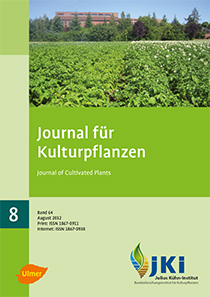Yield losses in winter wheat caused by important fungal diseases in 2003 to 2008 – results of trials of 12 German Federal Lands
Keywords:
Winter wheat, field plot trials, secondary evaluation, fungal diseases, yield losses between 2003 and 2008Abstract
A secondary evaluation of field plot trials for disease control in the years from 2003 to 2008 has been made to determine yield losses in winter wheat caused by fungal diseases. The calculation based on data gained in a total of 744 trials and had been submitted from plant protection services of 12 German Federal Lands. Fundamental data on the trials, the severity of the diseases occurring as well as the yields were transferred into an Oracle database. For the fact that neither infestation data nor those about yield losses were evenly distributed, the transformation was executed by a decimal logarithm. Based on the data gained, the best-suited quasilinear model was determined by SAS 9.2. The real infestation data helped calculate the lowest, average, and highest yield losses for the eight diseases selected according to the model.
On average, none of the diseases reached high average severities (> 40%) over all trials and years and consequently, high average yield losses. As expected, the highest yield losses were caused by Septoria Leaf Blotch (Mycosphaerella graminicola); the average yield loss amounted to 7 dt ha–1. Besides Septoria Leaf Blotch, Brown Rust (Puccinia triticina) also occurred in all German Federal Lands and turned out to be second important in both occurrence and yield loss. An average yield loss of only 2.5 dt ha–1 came as a surprise. Powdery Mildew (Blumeria graminis f. sp. tritici) and Tan Spot (Pyrenophora tritici-repentis) being other major leaf diseases caused low average yield losses of less than 2 dt ha–1. Stagonospora Leaf Blotch (Phaeosphaeria nodorum), which could be found in as few as 10 of the trials, had nearly no effect on the yield loss.
One of the foot and ear diseases each, Eyespot (Oculimacula spp.) and Fusarium Ear Blight, remained in the model. Yield losses caused by both diseases were low. The significance of foot diseases, which have been considered to be comparatively low over the past 10 years, was confirmed. The same applies to ear diseases, however, not to Fusarium spp. as far as the quality of harvested grains is concerned, which is not considered here.
DOI: 10.5073/JfK.2012.08.01, https://doi.org/10.5073/JfK.2012.08.01








